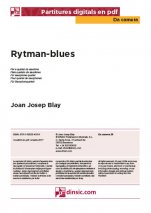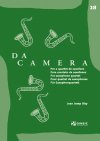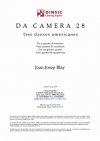Rytman-blues

Inside Pages
Author/Composer
Field
Music Schools and Conservatoires Elementary Level
Scores Elementary
Collection
Da Camera (separate PDF pieces) Nr. 2802
Language
Spanish, Catalan, Music, English, French, German
Format
Instrumental and vocal formations
Saxophone QuartetTechnical Specifications
Measurements
21 x 29,7 cm, vertical
Number of Pages
14
ISMN
979-0-69232-408-9
Editor
DINSIC Publicacions Musicals
Related Publications
Da Camera 28: Three American Dances for Saxophone Quartet
Array
(
[Relacionat] => Array
(
[id] => 1541
[publicacion_id] => 12661
[publicacion_id1] => 2268
[type] => relacionada
)
[pub] => Array
(
[Publicacion] => Array
(
[id] => 2268
[titol] => Da Camera 28: Three American Dances for Saxophone Quartet
[url] => score-dc28-da_camera_28_three_american_dances_for_saxophone_quartet
[codi] => DC28
[intro] =>
[continguts_generals] => These 'Three American dances' broaden the elementary repertoire in music schools, and I have also used them in the recorder version in secondary schools, either in instrumental music workshops or as part of extra-curricular activities.
Even though they are arranged for multi-instrument quartet, they can also be played with larger ensembles, by doubling the parts and combining tone colours at the discretion of the teacher in charge of the group.
This work, which is intended to be light, is a pleasure for the students it is aimed at, and it is also simple thanks to the clarity of its melody lines and its technical consistency.
Each of its movements can be played separately, even though it is written as a single work.
I hope you enjoy it when working on it.
The Composer
[estructuracio] =>
[material_descarga] => 0
[titol_descarga] =>
[info_descarga] =>
[num_pags] => 16
[ismn] =>
[diposit_legal] =>
[codi_barres] =>
[isbn] =>
[preu] => 14.90
[exhaurit] => 0
[oferta] => 0
[en_preparacio] => 0
[recomanat] => 0
[novetat] => 0
[format] => Partitura
[ctecnica] =>
[ilustracion] =>
[num_pagines_interiors] => 0
[n_pag_annex] =>
[numero_particelas] =>
[numero_pagines_particelas] =>
[durada] =>
[visible_instrumentacio] => 1
[visible_formacions] => 1
[pdf_car_estructuracio] => 0
[pes] => 0,09
[published] => 1
[created] => 2006-07-31 16:22:46
[modified] => 2025-07-07 03:17:44
[ordenacion] => 2006-07-31 16:22:46
[puntuacio] => 0.00
[visto] => 5520
[rating] => 0.0
[votes] => 0
[parent] =>
[has_child] => 0
[locale] => en_gb
)
[Audit] => Array
(
)
[Category] => Array
(
[0] => Array
(
[id] => 88
[url] => basico
[name] => Básico
[parent_id] => 78
[descripcio] =>
La clasificación del nivel de una partitura normalmente viene determinado por el grado de dificultad técnica del instrumento o voz. En los casos de obras para formaciones instrumentales diversas, orquestales, vocales, etc. el nivel se determina atendiendo a la complejidad general de la obra, no a la de sus instrumentos en particular. Es muy importante conocer este criterio porque las obras de conjunto aparecen también en los listados específicos de cada uno de sus instrumentos o voces que participan en él, pero el nivel que se indica es el de la formación instrumental-vocal.
[order] => 2
[lft] => 2
[rght] => 3
[published] => 1
[PublicacionsCategory] => Array
(
[id] => 284
[publicacion_id] => 2268
[category_id] => 88
)
)
)
[Idioma] => Array
(
[0] => Array
(
[id] => 116
[nom] => Catalan
[published] => 1
[url] => catalan
[PublicacionsIdioma] => Array
(
[id] => 477
[publicacion_id] => 2268
[idioma_id] => 116
)
)
[1] => Array
(
[id] => 103
[nom] => Castellà
[published] => 1
[url] => castella
[PublicacionsIdioma] => Array
(
[id] => 478
[publicacion_id] => 2268
[idioma_id] => 103
)
)
[2] => Array
(
[id] => 1724
[nom] => English
[published] => 1
[url] => english
[PublicacionsIdioma] => Array
(
[id] => 479
[publicacion_id] => 2268
[idioma_id] => 1724
)
)
[3] => Array
(
[id] => 1879
[nom] => Francés
[published] => 1
[url] => frances
[PublicacionsIdioma] => Array
(
[id] => 1872
[publicacion_id] => 2268
[idioma_id] => 1879
)
)
[4] => Array
(
[id] => 142
[nom] => Music
[published] => 1
[url] => international
[PublicacionsIdioma] => Array
(
[id] => 9113
[publicacion_id] => 2268
[idioma_id] => 142
)
)
)
[Rsspost] => Array
(
)
[Archivesrelation] => Array
(
[0] => Array
(
[Archivesrelation] => Array
(
[id] => 1942
[model] => Publicacion
[foreign_id] => 2268
[order] => 0
[file_id] => 2546
[archivestypes_id] => 2
)
)
[1] => Array
(
[Archivesrelation] => Array
(
[id] => 1943
[model] => Publicacion
[foreign_id] => 2268
[order] => 0
[file_id] => 2547
[archivestypes_id] => 3
)
)
)
[PublicacionsIdioma] => Array
(
[Idioma] => Array
(
[id] => 116
[nom] => Catalan
[published] => 1
[url] => catalan
[locale] => en_gb
)
)
)
[path] => scores-elementary
)
15.50 €











